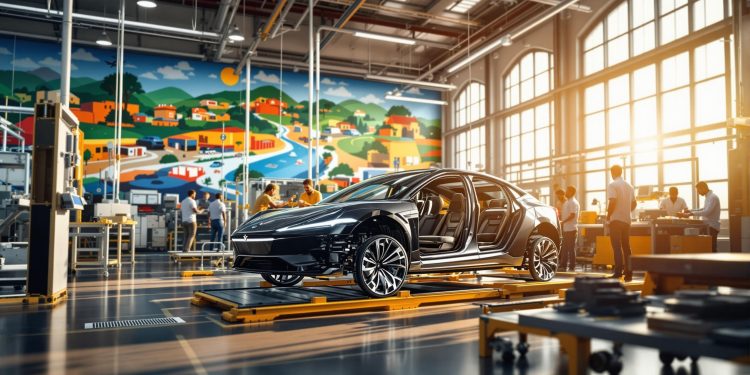South Africa’s auto industry is leveraging export tax incentives to stay competitive and expand globally. Key measures include:
- 150% tax deduction starting in 2026 for investments in electric and hydrogen vehicle production.
- Ongoing duty credits under the Motor Industry Development Program (MIDP) for exporting vehicles and components.
- Aiming to increase production to 1.4 million vehicles annually by 2035 under the SAAM 2021-2035 framework.
These incentives reduce production costs, encourage EV manufacturing, and address challenges like high shipping costs and global competition. With R8.8 billion invested by OEMs in 2021, South Africa is positioning itself for growth while transitioning to greener technologies.
Related video from YouTube
Challenges Facing South Africa’s Auto Exports
South Africa’s automotive industry plays a crucial role in the economy, contributing 5.3% to GDP (3.2% from manufacturing and 2.1% from retail). However, it faces hurdles that limit its ability to grow in international markets. These challenges affect its competitiveness and potential for long-term growth.
Competing with Global Auto Producers
South African automakers face tough competition from countries with advanced manufacturing systems and lower production costs. While the sector is vital to the economy, improving efficiency and reducing costs is essential to stay competitive. Export tax incentives can help offset the high production costs, making South African vehicles more price-competitive in global markets.
| Challenge Area | Current Status | Impact on Exports |
|---|---|---|
| Manufacturing Output | 21.9% of total output | Limits production capacity |
| Production Costs | Higher than competitors | Reduces price competitiveness |
The Shift to Electric Vehicles (EVs)
As the world moves toward electric vehicles (EVs), South Africa’s reliance on internal combustion engine (ICE) vehicle exports is under pressure. To stay relevant, the industry must invest in EV production and infrastructure. Offering tax incentives for EV investments can speed up this transition, helping South Africa maintain its position in the global market.
Trade and Shipping Barriers
High shipping costs and international trade restrictions are significant obstacles for South African auto exports. These factors reduce profitability and limit market access. Incentives, like the 150% tax deduction on investments in electric and hydrogen-powered vehicle production [2], can help manufacturers address these barriers while shifting toward future-ready vehicle production.
Tackling these issues requires creative strategies, with export tax incentives serving as a key tool to transform the industry and secure its place in global markets.
How Export Tax Incentives Work
South Africa’s export tax incentives play a crucial role in strengthening the automotive sector by encouraging investment, cutting production costs, and supporting the shift to electric vehicles (EVs).
Main Features of Export Tax Incentives
At the heart of South Africa’s export incentive program is a 150% tax deduction for investments in producing electric and hydrogen-powered vehicles, starting in 2026 [2]. This tax benefit covers buildings and equipment used mainly for EV production, motivating manufacturers to upgrade their facilities.
| Incentive Type | Benefit | Implementation Date |
|---|---|---|
| EV Production Investment | 150% tax deduction | 2026 |
| Advanced Manufacturing | Tax breaks on equipment | Current |
| Export Credit Support | Duty credits for exports | Ongoing |
Comparing Current and Past Policies
The current incentive framework focuses on EV production and sustainable manufacturing, building on earlier policies. The South African Automotive Masterplan (SAAM) 2021-2035 outlines a vision to grow the country’s share of global vehicle production to 1% by 2035 [1]. This marks a clear shift toward future-ready manufacturing.
Boosting Competitiveness and Drawing Investment
These incentives tackle industry challenges like high production costs and the transition to EV manufacturing. The results are evident in the sector’s growth, with Original Equipment Manufacturers (OEMs) investing R8.8 billion and the component sector adding R5.7 billion in 2021 [1].
sbb-itb-09752ea
Using Export Tax Incentives Effectively
To make the most of export tax incentives, South African automakers need a well-rounded strategy that balances production priorities, addresses infrastructure challenges, and explores new markets.
Balancing ICE and EV Production
Automakers must carefully manage investments in both EV and ICE production. The 150% tax deduction for EV-related investments starting in 2026 encourages manufacturers to upgrade facilities for EV production. At the same time, improving ICE production efficiency remains key to keeping costs under control.
| Production Focus | Tax Benefit | Strategic Plan |
|---|---|---|
| EV Manufacturing | 150% deduction | Invest in new facilities |
| ICE Production | Standard rates | Enhance efficiency |
| Hybrid Solutions | Combined benefits | Share infrastructure |
Addressing Infrastructure Challenges
Infrastructure plays a pivotal role in supporting export growth, especially for EVs. CHARGE is leading efforts to build South Africa’s first off-grid, renewable-powered national charging network. This initiative directly supports the government’s push for a more sustainable automotive industry.
Improving infrastructure not only aids domestic EV adoption but also strengthens South Africa’s ability to expand its export footprint, particularly in regional and kit markets.
Boosting Regional and Kit Exports
The automotive sector is using tax incentives to grow regional exports and semi-knocked down (SKD) kit assembly operations. This aligns with the South African Automotive Masterplan’s goal to increase the country’s global vehicle production share, currently at 0.65% [1]. In 2021 alone, OEMs invested R8.8 billion, showcasing early progress [1].
To scale regional and kit exports, manufacturers are focusing on affordable SKD kits, building stronger trade relationships, and enhancing logistics to handle greater export volumes. These efforts, paired with smart use of tax incentives, are positioning South Africa to meet its long-term export and sustainability objectives.
What’s Next for South Africa’s Auto Exports?
Expected Growth in Exports
South Africa’s automotive industry is targeting the production of 1.4 million vehicles annually by 2035, a significant leap from its current 0.65% share of the global market. Investments made in 2021 signal confidence in this ambitious goal, with industry players showing clear commitment to expansion.
This progress is being driven by supportive policies and a shared sense of optimism among industry leaders and policymakers.
Perspectives from Industry and Policymakers
Both industry experts and government officials are encouraged by export tax incentives, such as the 150% tax deduction for producing electric and hydrogen-powered vehicles [2]. These measures are seen as key to attracting foreign investment and strengthening South Africa’s position in the global automotive sector.
Efforts are also being made to balance traditional vehicle production with the shift toward new energy technologies. Policymakers stress the importance of maintaining South Africa’s role in global supply chains while preparing for the increasing demand for electric and hydrogen-powered vehicles.
These strategies aim to sharpen South Africa’s competitive edge while aligning with broader environmental and economic objectives.
Advancing Green Energy and Economic Goals
The transformation of South Africa’s automotive sector isn’t just about producing vehicles – it’s part of a larger push toward sustainable practices. By focusing on environmentally friendly manufacturing, the country has the opportunity to lead in the global shift to green energy, which could further boost export potential.
These initiatives are designed to create long-term jobs, attract advanced technologies, and develop green energy infrastructure. They also align with South Africa’s dual goals of economic growth and environmental stewardship [3].
Collaboration between government and industry will be crucial to ensuring South Africa stays competitive while meeting its environmental and economic commitments [3].
Conclusion: The Future of South Africa’s Auto Exports
South Africa’s automotive export industry is evolving, thanks to export tax incentives designed to modernize manufacturing and boost global competitiveness. These measures are shaping the future of the sector, building on its established success in expanding export markets.
The push for growth is backed by incentives that support both traditional vehicle production and the growing electric vehicle market. Agreements with Chinese electric vehicle manufacturers, supported by these tax incentives, are paving the way for increased local manufacturing and export opportunities [2].
By encouraging the production of green vehicles while still supporting traditional manufacturing, South Africa is carving out a strong position in the global automotive market [3]. The tax program marks a major step in this direction.
"The tax incentive comes into effect in 2026 and will enable manufacturers to deduct 150% of the cost of buildings and equipment used primarily for producing electric and hydrogen-powered vehicles." – CHARGE [2]
To fully take advantage of these benefits, the industry must address challenges like improving local content and expanding markets. Close collaboration between the government and the private sector will be key to strengthening South Africa’s role in the global supply chain and advancing sustainable production [4].
Related Blog Posts
- SA EV Sales Growth 2025: Key Numbers
- How Exchange Rates Affect Car Prices in South Africa
- Luxury Car Market in South Africa: 2025 Price Forecast
- EV Buyers in South Africa: Emissions and Behavior





